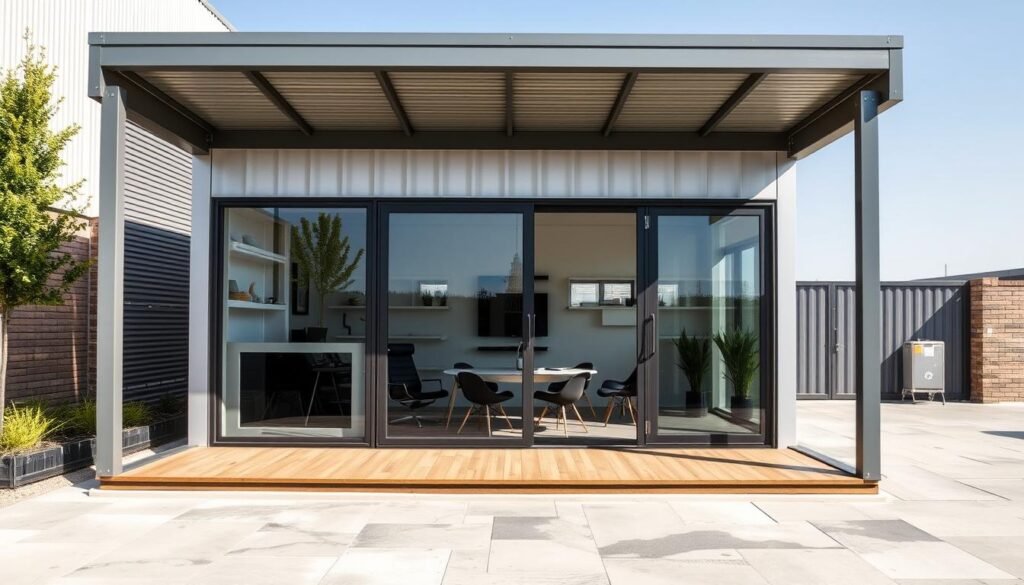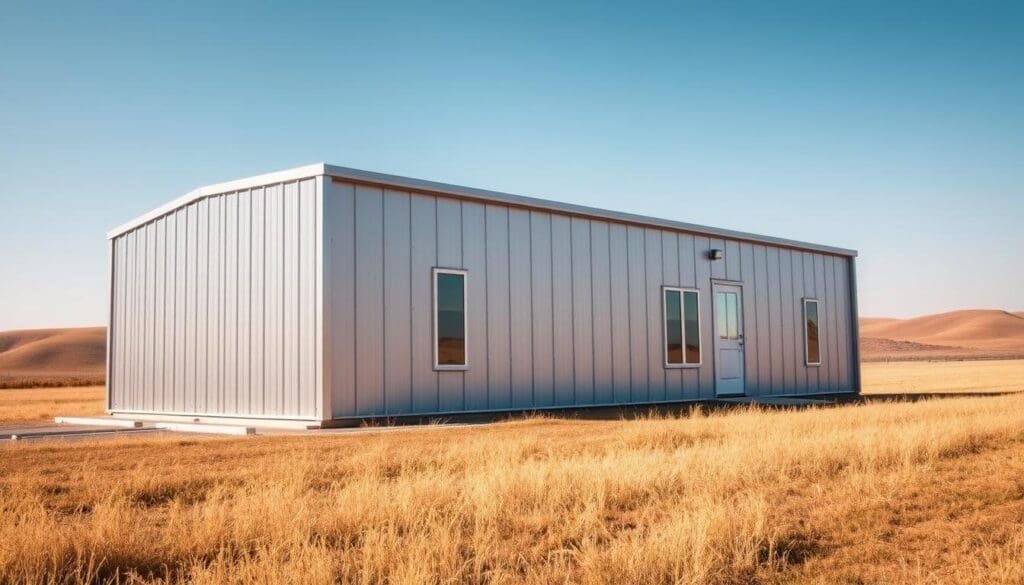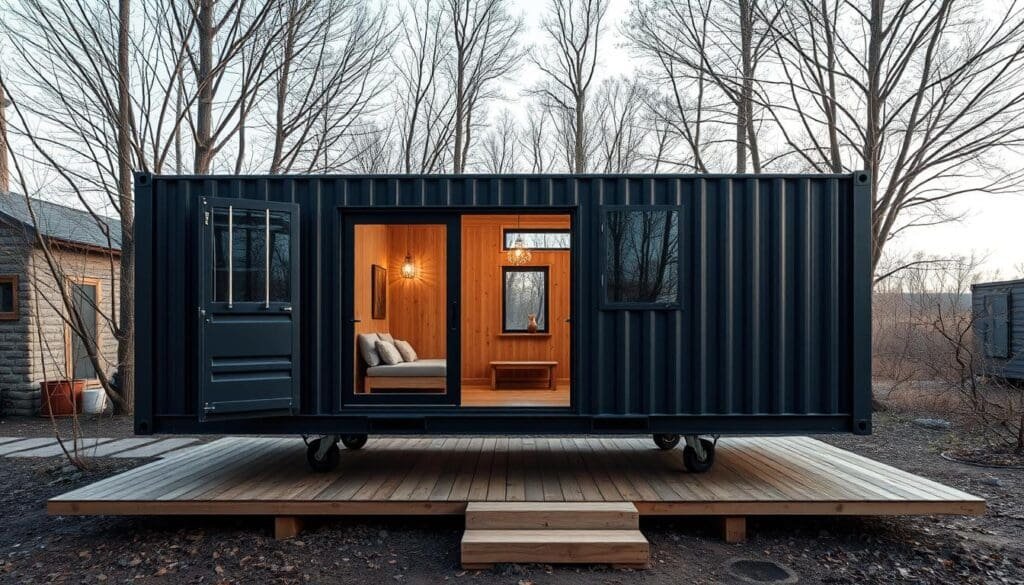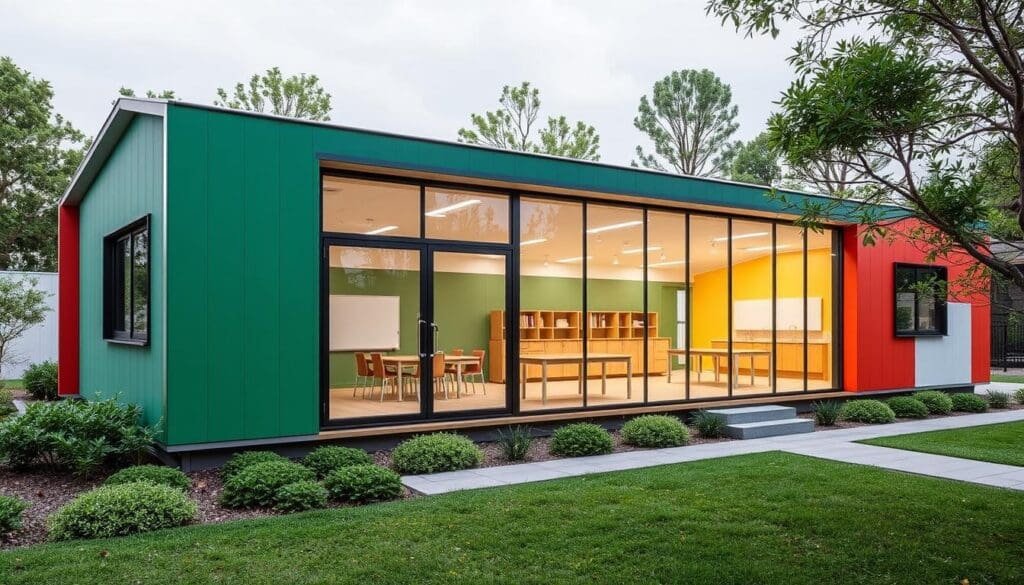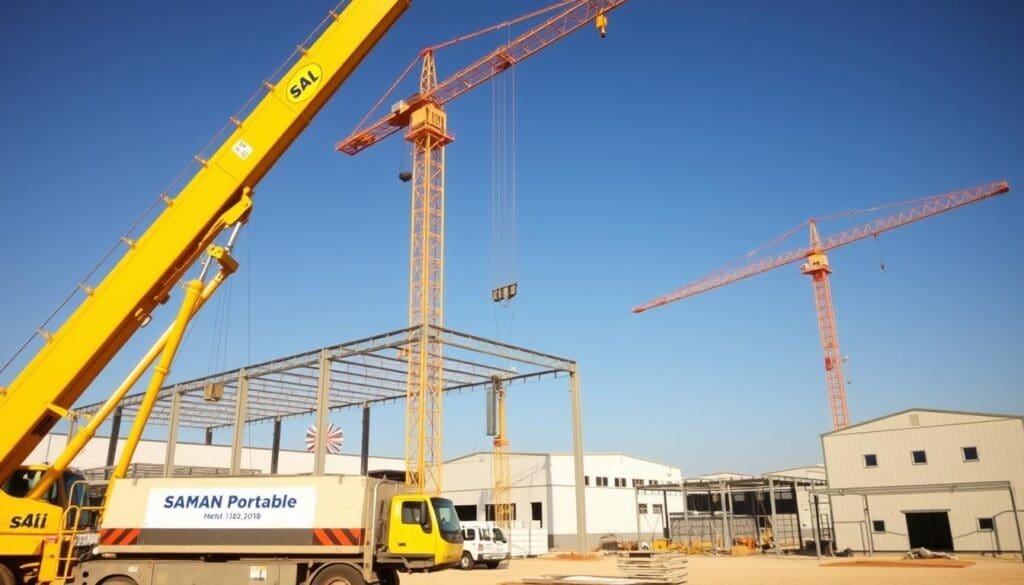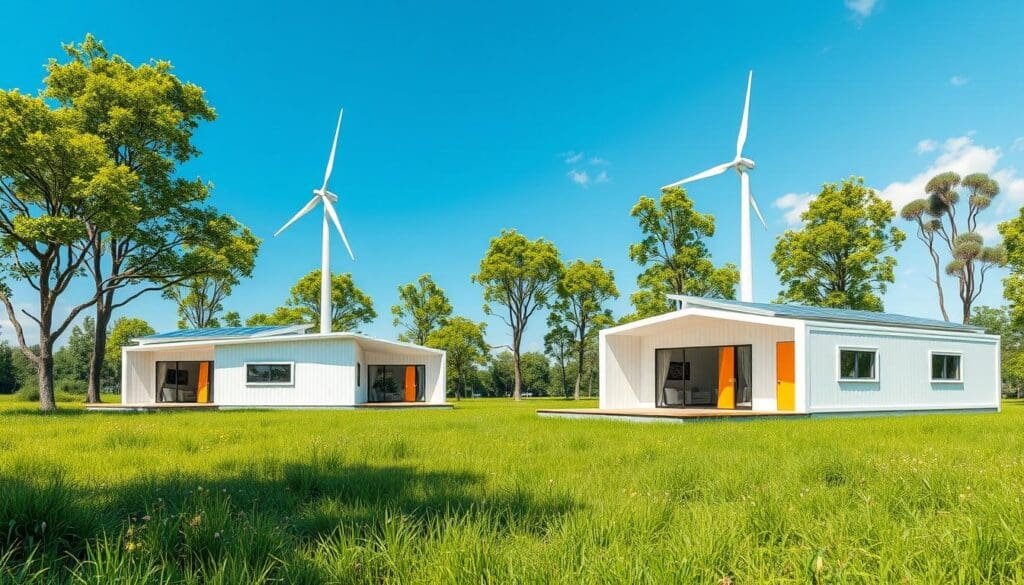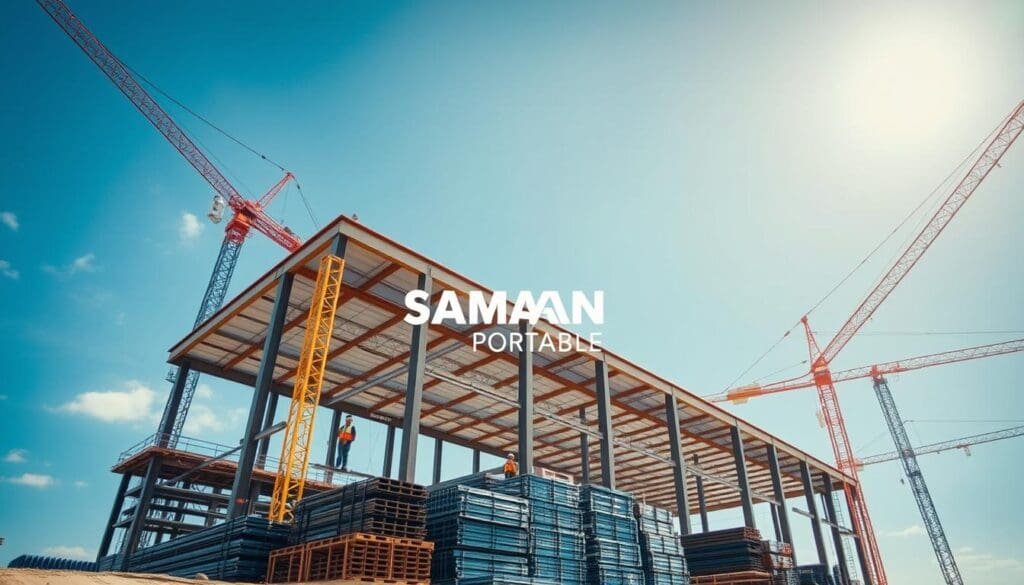Prefab Steel Buildings: Strong, Durable, and Cost-Effective for All Applications
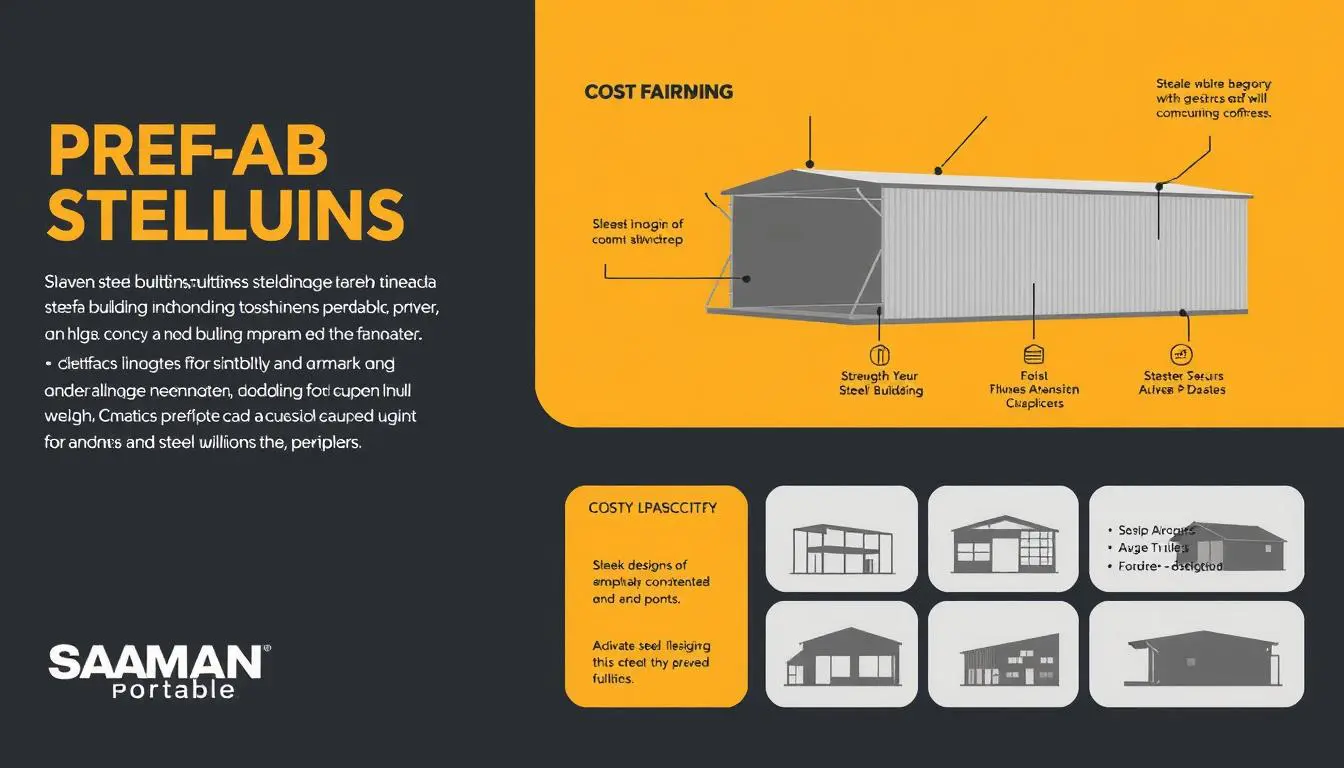
In today’s ever-evolving world of construction, one solution stands out as a game-changer: prefabricated steel buildings. These innovative structures are revolutionizing the way we approach commercial, industrial, and even residential projects. But what if we told you that these prefab steel buildings offer more than just a sturdy, reliable frame? What if they could also provide substantial cost savings and environmental benefits? Prepare to be amazed as we explore the remarkable advantages of this transformative building technology.
Key Takeaways
- Prefab steel buildings offer up to 30% energy savings compared to conventional construction methods.
- Steel buildings require up to 50% less maintenance costs over time due to their durability.
- Steel-framed buildings can withstand extreme weather conditions, reducing the risk of structural damage.
- Prefab steel buildings provide over 20% in longevity cost savings on maintenance and repairs.
- EPACK Prefab, a leading PEB producer in India, has over 24 years of experience in providing durable and cost-effective structures.
Understanding Modern Prefab Steel Construction
The world of prefab steel construction has evolved remarkably, offering innovative solutions across various industries. In India, the market for prefab steel buildings is experiencing rapid growth, driven by the need for quick, efficient, and cost-effective construction alternatives.
Evolution of Steel Building Technology
Steel has long been recognized for its exceptional strength-to-weight ratio, making it a premier choice for structural building materials. Advancements in steel fabrication and engineering have further enhanced the capabilities of prefab steel construction. Today, these buildings are engineered to withstand diverse environmental conditions and exceed anticipated loads throughout their lifespan.
Current Market Trends in India
The demand for prefab houses for sale and Eco-Friendly Porta Cabins in India is on the rise, as businesses and organizations seek sustainable and flexible building solutions. Portable Porta Cabins have become increasingly popular, providing versatile and cost-effective options for a variety of applications.
Key Components of Prefab Structures
The core components of prefab steel buildings include the primary frame, secondary members, roof and wall systems, and strategic connections. These elements are meticulously engineered to optimize structural integrity, ensuring the durability and longevity of the structures.

By understanding the evolution of steel building technology and the current market trends in India, we can explore the versatility and advantages of prefab houses for sale, Portable Porta Cabins, and Eco-Friendly Porta Cabins.
The Rising Demand for Prefab Steel Buildings
The global demand for Portable Living Cabins, Premium Portable Cabins, and Modular Portable Cabins is on the rise, driven by their numerous advantages. These prefab steel buildings offer quick installation, low maintenance, and superior durability at competitive prices, making them an attractive option for a wide range of applications.
One sector that has seen a significant surge in the adoption of prefab steel buildings is the food industry. These structures are being widely used for food preservation facilities, packaging sections, distribution centers, and production areas, thanks to their versatility and adaptability. Businesses in the food industry are recognizing the efficiency and cost-effectiveness that prefab steel buildings bring to their operations.
The Prefab Steel Buildings Market is estimated to reach US$ XX Bn by 2024 and is projected to grow at a compound annual growth rate (CAGR 2024-2031) of xx.xx%, leading to a market volume of US$ xx.xx Bn by 2031. This remarkable growth trajectory underscores the increasing popularity and widespread adoption of these innovative building solutions.
With more than 110 global marketplaces, rivals, and Fortune 500+ businesses involved in the Prefab Steel Buildings market, the industry showcases its broad reach and competitiveness. Manufacturers such as BlueScope Steel, NCI Building Systems, Nucor Corporation, and PEBS Pennar are leading the charge, offering high-quality Portable Living Cabins, Premium Portable Cabins, and Modular Portable Cabins to meet the growing demand.

The versatility and adaptability of Portable Living Cabins, Premium Portable Cabins, and Modular Portable Cabins make them an attractive option for businesses seeking efficient and cost-effective construction solutions. As the industry continues to evolve, we can expect to see even greater innovation and growth in the prefab steel building sector, transforming the way we approach construction and development.
Core Advantages of Steel Building Solutions
Prefab steel buildings offer a host of compelling advantages that make them an attractive choice for businesses and organizations across India. From their exceptional structural strength and durability to their cost-effectiveness and environmental benefits, these innovative construction solutions are revolutionizing the way we approach industrial and commercial projects.
Structural Strength and Durability
Prefabricated steel structures are engineered to withstand the toughest conditions, with a high load-bearing capacity that reduces deformation, cracking, and warping over time. The steel frames are designed for exceptional fire resistance, surpassing the melting threshold of materials like wood and concrete, and offering passive fire containment to protect occupants. Moreover, the galvanized or painted steel components are highly resistant to rust and corrosion, ensuring minimal maintenance requirements.
Cost-Effectiveness and ROI
Prefab steel buildings offer unparalleled cost-efficiency, with up to 50% reductions in labor costs and significant savings on heating and cooling expenses due to their insulated panels. The factory-built components and pre-planned specifications also allow for a faster building process, cutting construction timelines in half compared to traditional methods. Additionally, the ability to deconstruct, move, and reassemble these structures makes them a highly cost-effective solution that can be repurposed for different needs over time.
Environmental Benefits
Sustainability is a key priority in the construction industry, and prefab steel buildings are leading the way. These structures are engineered for energy efficiency, with insulated panels that reduce heating and cooling demands. Furthermore, the recyclable steel materials used in their construction contribute to a lower carbon footprint, making them a environmentally responsible choice for businesses and organizations in India.
With their combination of structural integrity, cost-effectiveness, and environmental stewardship, prefab steel buildings are poised to transform the way we approach Portable Cabins India, Container Offices Near You, and Flexible Container Offices across the country.

Industrial Applications and Versatility
Prefab steel buildings have diverse applications in the industrial sector, showcasing their versatility. These robust structures are well-suited for warehouses, manufacturing facilities, and storage solutions, offering a range of benefits that cater to the specific needs of various industries.
One notable application is in the food industry, where prefab steel buildings excel. They provide solutions for food preservation facilities, packaging sections, distribution centers, and production areas. The customizable nature of these buildings allows for the creation of temperature-controlled environments, ensuring the optimal storage and preservation of perishable goods.
- Affordable Container Spaces – Prefab steel buildings can be designed as cost-effective, Affordable Container Spaces for industrial storage and logistics operations.
- Compact Portable Offices – These versatile structures can also be configured as Compact Portable Offices within industrial facilities, offering flexible workspace solutions.
- Flexible Portable Workspaces – The modular design of prefab steel buildings enables the creation of Flexible Portable Workspaces that can be easily reconfigured to meet changing operational requirements.
The versatility of prefab steel buildings is further demonstrated in their ability to accommodate large machinery, tall ceilings, and wide-open spaces – essential features for various industrial applications. With their customization capabilities, these structures can be tailored to the unique needs of each industrial sector, making them a valuable asset for businesses seeking efficient and cost-effective solutions.

Design Flexibility and Customization Options
When it comes to prefab steel buildings, the possibilities for design flexibility and customization are truly remarkable. These structures offer a wide range of architectural possibilities, allowing businesses to create visually stunning and functional spaces that align with their unique brand identity and requirements.
Architectural Possibilities
From diverse roof styles to versatile wall systems and captivating facade treatments, prefab steel buildings can be tailored to suit a variety of aesthetic preferences. Whether you desire a traditional gabled roof, a sleek and modern flat roof, or a striking arched design, the Portable Office Manufacturer has the expertise to bring your architectural vision to life.
Space Optimization Techniques
- Mezzanine floors to maximize usable vertical space
- High ceilings for efficient storage and equipment placement
- Customizable layouts to optimize workflow and productivity
Aesthetic Considerations
Businesses can choose from a wide range of colors, finishes, and cladding options to create a visually appealing small portable office for sale that reflects their brand identity. From sleek metal panels to warm wooden accents, the possibilities are endless, allowing you to craft a prefab office that is both functional and aesthetically pleasing.

By leveraging the design flexibility and customization options offered by prefab steel buildings, businesses can create spaces that not only meet their practical needs but also enhance their overall brand presence and appeal to their target audience.
Energy Efficiency and Insulation Features
Prefab steel buildings are designed with energy efficiency in mind, incorporating features that significantly reduce operational costs and environmental impact. The structural integrity and insulation properties of these sustainable architecture buildings make them an attractive choice for businesses seeking to minimize their energy consumption and carbon footprint.
One of the key energy-saving features of prefab steel buildings is their insulated sandwich panel claddings on walls and roofs. These panels effectively trap heat, reducing the need for extensive heating and cooling systems and leading to substantial savings on utility bills. The structural design also allows for ample natural light, decreasing the reliance on artificial lighting and further contributing to energy savings.
- Steel buildings consume up to one-third less energy and approximately two-thirds less electricity compared to traditional construction.
- Proper insulation and airtight construction in prefab steel buildings can achieve U-values of less than 0.15 W/m^2K and airtightness levels below 3 m^3/m^2/h, significantly improving thermal performance.
- Integrating solar power and smart building technology into prefab steel structures enhances long-term energy efficiency and sustainability.
By prioritizing energy efficiency and insulation, prefab steel buildings offer a sustainable and cost-effective solution for Eco-Friendly Porta Cabins and other commercial and industrial applications. These features make them an increasingly popular choice for businesses seeking to reduce their environmental impact and operational costs.

Prefab Steel Buildings in Commercial Spaces
As the demand for sustainable and efficient commercial spaces continues to rise, prefab steel buildings have emerged as a versatile solution. These modular structures offer a range of advantages that make them increasingly popular in retail, office, and warehouse applications.
Retail Applications
In the retail sector, Portable Porta Cabins and Premium Portable Cabins constructed with prefab steel provide flexible layouts and large windows that allow for ample natural light. This enhances the shopping experience and creates an inviting atmosphere for customers. The modular design of these Modular Portable Cabins also enables easy reconfiguration, allowing retailers to adapt their spaces to evolving business needs.
Office Solutions
Prefab steel buildings are also making a mark in the office sector. The modular design of these structures allows for seamless expansion and reconfiguration, enabling businesses to accommodate growth and adapt to changing workspace requirements. Additionally, the spacious, column-free interiors of prefab steel office solutions optimize workflow and collaboration.
Warehouse Implementations
Warehouses and logistics hubs have also embraced the benefits of prefab steel buildings. These structures offer large, open spans and high ceilings, providing ample storage space and optimizing material handling operations. The structural integrity and durability of prefab steel ensure these commercial spaces can withstand the demands of heavy-duty warehouse activities.
The versatility of prefab steel buildings in commercial spaces is a testament to their adaptability and the growing recognition of their advantages in the Indian market. As businesses seek sustainable and cost-effective solutions, these modular structures continue to gain traction across various commercial applications.

Construction Timeline and Process
When it comes to Portable Cabins India and Container Offices Near You, the construction timeline and process are significantly faster compared to traditional building methods. The prefabricated nature of steel buildings allows components to be manufactured off-site, reducing the time spent on-site and minimizing disruptions to your operations.
The typical construction process for a prefab steel building involves several key steps:
- Site Preparation: Clearing the site, leveling the ground, and laying the foundation to ensure a stable and level base for the structure.
- Frame Assembly: Erecting the steel frame, which is the core of the building, using cranes and specialized equipment.
- Wall and Roof Installation: Attaching the walls and roof panels, which are pre-engineered to fit the frame seamlessly.
- Finishing Touches: Adding any necessary insulation, doors, windows, and other finishing elements to complete the structure.
This efficient construction process allows businesses to become operational much faster, providing a competitive advantage in terms of time-to-market. In fact, studies show that a 2,400 square foot steel garage or pole barn with a 40-foot clear span can be framed in less than a week. By optimizing the construction timeline, prefab steel buildings offer a practical and time-saving solution for a wide range of applications.

Careful planning and execution are crucial to ensuring a smooth construction process. Weather conditions can be the primary cause of delays, so it’s essential to have a well-coordinated team and a flexible schedule to overcome any unforeseen challenges. By adhering to safety protocols and quality standards, businesses can ensure that their prefab steel building project is completed on time and to the highest standards.
Maintenance and Long-term Cost Benefits
When it comes to Flexible Container Offices and Affordable Container Spaces, prefabricated steel buildings offer significant long-term cost benefits due to their low maintenance requirements. Regular upkeep is minimal, primarily involving periodic inspections and cleaning. Unlike traditional structures, steel does not decay, rust, or encourage the growth of fungi and bacteria, eliminating many common maintenance issues.
Regular Upkeep Requirements
Prefab steel buildings require minimal maintenance over their lifespan. The key upkeep tasks include:
- Periodic inspections to check for any structural issues or damage
- Cleaning the exterior and interior surfaces to maintain their pristine appearance
- Occasional repainting or touch-ups to protect the steel from weathering
These simple, infrequent maintenance procedures help ensure the long-term durability and performance ofFlexible Container OfficesandAffordable Container Spacesconstructed with prefabricated steel.
Lifecycle Cost Analysis
A comprehensive lifecycle cost analysis reveals the significant savings that prefab steel buildings offer over the long term. Factors such as energy efficiency, structural integrity, and reduced repair needs contribute to substantial cost benefits compared to traditional construction methods. Steel’s inherent strength and resistance to decay result in buildings that last for decades with minimal investment in upkeep, making them a smart choice for businesses seeking Affordable Container Spaces and Flexible Container Offices.
The combination of low maintenance requirements and durable performance makes prefab steel buildings a wise long-term investment for businesses and organizations seeking cost-effective, sustainable solutions for their facility needs.
Safety Features and Regulatory Compliance
When it comes to Compact Portable Offices and Flexible Portable Workspaces, safety is of paramount importance. Prefab steel buildings are engineered to incorporate numerous safety features and are designed to meet or exceed regulatory compliance standards. These buildings offer excellent fire resistance, wind load capacity, and seismic performance, providing a secure and reliable environment for occupants and operations.
In the food industry, for instance, prefab steel buildings can be designed to meet strict hygiene and safety regulations. Features like smooth surfaces make these structures easy to clean and disinfect, ensuring a hygienic workspace. Compliance with local building codes and industry-specific regulations is a hallmark of prefab steel construction, ensuring the safety and well-being of all who utilize these spaces.
- Stringent adherence to building codes and safety standards
- Excellent fire resistance and seismic performance
- Smooth, easy-to-clean surfaces for hygienic environments
- Customized solutions to meet industry-specific regulations
The safety and regulatory compliance of prefab steel buildings are critical factors that contribute to their widespread adoption in a variety of applications, from Compact Portable Offices to Flexible Portable Workspaces. By prioritizing these essential features, these structures provide a secure and compliant environment for businesses and individuals alike.

Continuous advancements in materials, production techniques, and building systems are expected to further enhance the efficiency, performance, and safety of prefabricated steel buildings in the future. This ongoing innovation ensures that these Compact Portable Offices and Flexible Portable Workspaces remain at the forefront of safety and regulatory compliance, meeting the evolving needs of businesses and industries.
Environmental Impact and Sustainability
Prefab steel buildings are a shining example of sustainable architecture, aligning with the growing demand for eco-friendly construction solutions. These structures not only contribute to green building standards but also boast impressive recycling potential and a reduced carbon footprint.
Green Building Standards
Prefab steel buildings are designed to meet the stringent requirements of green building certifications like LEED and BREEAM. The use of recycled materials, energy-efficient features, and minimized site disturbance during construction ensure these structures adhere to the highest environmental standards.
Recycling Potential
The steel used in prefab buildings is often made from recycled materials, and the structures themselves are fully recyclable at the end of their lifespan. This circular economy approach reduces waste and conserves natural resources, making prefab steel buildings a sustainable choice for businesses committed to environmental responsibility.
Carbon Footprint Reduction
The efficient manufacturing and construction processes of prefab steel buildings contribute to a lower carbon footprint throughout the building’s lifecycle. From reduced energy consumption during production to energy-efficient design features, these structures help businesses minimize their environmental impact and support the global effort to combat climate change.
By embracing the sustainable advantages of prefab steel buildings, businesses can demonstrate their commitment to environmental stewardship while enjoying the practical benefits of cost-effective, durable, and versatile construction solutions. Eco-Friendly Porta Cabins and other sustainable architecture buildings are paving the way for a greener future in the construction industry.
Cost Analysis and Financial Planning
When it comes to constructing sustainable and cost-effective buildings, prefab steel structures offer a compelling solution. A comprehensive cost analysis reveals the favorable financial outcomes that businesses can expect from these innovative structures. The initial construction costs for prefab steel buildings are often lower than traditional methods, thanks to reduced labor requirements and minimal material waste. Moreover, the speed of construction translates to earlier occupancy and revenue generation, making them a smart investment for Portable Office Manufacturers and businesses seeking small portable offices for sale.
Beyond the initial costs, the long-term savings associated with prefab steel buildings are equally impressive. These structures boast exceptional energy efficiency, which translates to lower utility bills and a smaller carbon footprint. Additionally, the low maintenance requirements of steel construction further contribute to the overall cost-effectiveness of these solutions. When considering the financial planning for prefab steel buildings, businesses should factor in these savings, as well as potential tax incentives for energy-efficient or sustainable construction, to accurately assess the return on investment (ROI).
According to recent industry data, steel frames accounted for 98.7% of all industrial shed building construction in the UK in 2023, highlighting the growing popularity and cost-effectiveness of this solution. In comparison, only 0.2% of industrial buildings were constructed using in-situ concrete, 0.6% using precast concrete, and 0.5% using load-bearing masonry. The cost range (excluding cladding rails and purlins) for low eaves, single-story industrial units with a steel portal frame solution is typically between £108 and £142 per m2 GIFA, while high-eaves buildings (10m to 13m high) can cost between £132 to £169 per m2 GIFA.
By considering these factors and collaborating closely with the design team and supply chain, businesses can develop a comprehensive financial plan that accurately reflects the true value of prefab steel buildings. This strategic approach ensures that the initial investment and long-term savings are well-aligned, making prefab steel a prudent choice for Portable Office Manufacturers and businesses in search of small portable offices for sale.
Weather Resistance and Durability Features
Prefab steel buildings are renowned for their exceptional weather resistance and durability. These structures are engineered to provide superior protection against the most challenging natural elements, ensuring your investment remains secure and reliable even in the face of extreme weather conditions.
Protection Against Natural Elements
Prefab steel buildings are designed to withstand the onslaught of wind, rain, snow, and UV radiation. With their inherent strength and advanced engineering, these structures can effectively resist wind uplift and lateral forces during powerful storms. In 2020, the United States experienced a record of 30 named storms during the hurricane season, underscoring the growing need for storm-resistant infrastructure like prefabricated steel buildings.
Structural Integrity in Extreme Conditions
The structural integrity of prefab steel buildings is maintained even in the face of extreme conditions, such as high winds and seismic activity. Steel’s exceptional tensile strength allows these structures to withstand heavy snow loads, earthquakes, and other natural disasters with ease. This makes them a reliable choice for applications in diverse climate zones and environments prone to natural calamities.
MBMI Metal Buildings, a leading provider of prefabricated steel solutions, specializes in delivering customized storage and commercial structures that can withstand harsh weather conditions. Their buildings feature advanced coating and corrosion resistance, adding decades to their lifespan and ensuring long-term durability.
Prefabricated metal buildings not only offer exceptional weather resistance but also demonstrate environmental responsibility. By using pre-engineered components, these structures can reduce material waste and minimize disruptions to the surrounding environment during the construction process. EPACK Prefab, another renowned player in the industry, has delivered approximately 7,400 projects and currently has over 1,000 projects in the pipeline, showcasing the growing demand for these resilient and sustainable solutions.
Future Trends in Prefab Steel Construction
The world of prefab steel construction is poised for an exciting future, with emerging trends that promise greater sustainability, innovation, and cost-effectiveness. As the demand for sustainable architecture buildings and Modular Portable Cabins continues to grow, the industry is responding with advancements that cater to the evolving needs of businesses and communities.
One key trend is the increasing focus on modular design. Prefab steel buildings are becoming more adaptable and customizable, allowing for easy expansion, modification, or relocation as needed. This flexibility empowers businesses to tailor their spaces to their unique requirements, enhancing their brand identity and purpose.
Alongside modular design, the integration of smart building technologies is on the rise. Prefab steel structures are incorporating renewable energy systems, advanced insulation materials, and intelligent automation features, all aimed at improving energy efficiency and reducing the carbon footprint. The use of recycled materials and eco-friendly construction practices further solidifies the industry’s commitment to sustainability.
Automation and offsite construction are also transforming the way prefab steel buildings are manufactured and assembled. Advancements in Building Information Modeling (BIM) and 3D printing are enabling the creation of complex, visually appealing structures that were once unattainable through traditional methods. This increased precision and efficiency are expected to drive down construction timelines and costs, making prefab steel solutions even more attractive to businesses and developers.
As the industry continues to evolve, we can anticipate a future where sustainable architecture buildings and Modular Portable Cabins seamlessly integrate cutting-edge technology, environmentally responsible practices, and unparalleled design flexibility. The prefab steel construction industry is poised to lead the way in redefining the built environment, delivering cost-effective, durable, and eco-friendly solutions for a wide range of applications.
Choosing the Right Manufacturer in India
When it comes to prefab steel buildings, selecting the right manufacturer in India is crucial for project success. Portable Cabins India and Portable Office Manufacturer play a significant role in ensuring your construction project is cost-effective, versatile, and durable.
One of the key factors to consider is the manufacturer’s experience. Look for a reputable company like Kaizen Smartbuilt, which has a proven track record of delivering high-quality prefab steel buildings. Review their portfolio, certifications, and client testimonials to ensure they can meet your specific project requirements.
- Look for manufacturers with a strong emphasis on quality standards and customization capabilities.
- Ensure the manufacturer offers comprehensive after-sales support to address any issues that may arise during the lifetime of the building.
Another important aspect is the manufacturer’s financial stability. A financially sound and well-managed company is better equipped to adapt to market changes and deliver consistent project timelines. The pre-engineered building market size in India is expected to reach $0.888 billion by 2032 with a Compound Annual Growth Rate (CAGR) of 7.40%, underscoring the importance of choosing a reliable Portable Cabins India or Portable Office Manufacturer.
By selecting the right manufacturer, you can ensure that your prefab steel building project is cost-effective, versatile, and durable, meeting your specific needs while contributing to the growth of the Indian construction industry.
Conclusion
Prefab steel buildings represent a robust and versatile solution that is transforming the construction industry in India and globally. With their exceptional structural integrity, cost-effectiveness, and environmental benefits, these innovative structures are poised to play a pivotal role in shaping the future of sustainable architecture and infrastructure development.
From faster construction timelines and reduced labor costs to enhanced energy efficiency and minimal maintenance requirements, prefab steel buildings offer a multitude of advantages that make them an attractive choice for businesses and organizations across various sectors. As the demand for sustainable and eco-friendly building solutions continues to grow, the widespread adoption of prefab steel will undoubtedly contribute to a more sustainable and resilient built environment.
RBS World, a prominent manufacturer and supplier of quality Pre-Engineered Building (PEB) construction solutions, is at the forefront of this industry shift, providing cutting-edge prefab steel building systems that cater to the diverse needs of our clients. By leveraging the latest advancements in steel technology and construction methodologies, we are committed to delivering innovative, cost-effective, and environmentally responsible building solutions that will shape the future of the construction industry in India and beyond.
FAQ
What are the key advantages of prefab steel buildings?
Prefab steel buildings offer numerous advantages, including structural strength, durability, cost-effectiveness, quick installation, low maintenance, energy efficiency, and environmental benefits.
How are prefab steel buildings constructed?
Prefab steel buildings are constructed using a modular approach, where components are manufactured off-site and then assembled on-site. This process involves site preparation, foundation work, assembly of the steel frame, installation of roof and wall systems, and finishing.
What are the common applications of prefab steel buildings?
Prefab steel buildings are used in a wide range of applications, including houses, office spaces, hangars, factories, warehouses, stadium structures, cold storage spaces, railway auditoriums, and shopping malls.
How do prefab steel buildings contribute to sustainability?
Prefab steel buildings are environmentally responsible, with features like energy-efficient design, use of recycled materials, and reduced construction waste. They also have a lower carbon footprint compared to traditional construction methods.
What are the cost benefits of choosing prefab steel buildings?
Prefab steel buildings offer significant cost benefits, including lower initial construction costs, reduced material waste, and minimal maintenance requirements, leading to a favorable return on investment over the building’s lifecycle.
How do prefab steel buildings ensure safety and regulatory compliance?
Prefab steel buildings are designed to meet or exceed safety standards, offering excellent fire resistance, wind load capacity, and seismic performance. They can also be customized to comply with specific industry regulations, such as those in the food industry.
What are the future trends in prefab steel construction?
Future trends in prefab steel construction include advancements in modular design, increased use of smart building technologies, and integration of renewable energy systems, all aimed at improving performance, sustainability, and cost-effectiveness.
How can I choose the right prefab steel building manufacturer in India?
When selecting a prefab steel building manufacturer in India, it’s important to consider factors such as the manufacturer’s experience, quality standards, customization capabilities, and after-sales support. Reviewing the manufacturer’s portfolio, certifications, and client testimonials can help ensure a successful project.
 Container Cafe
Container Cafe
















































































